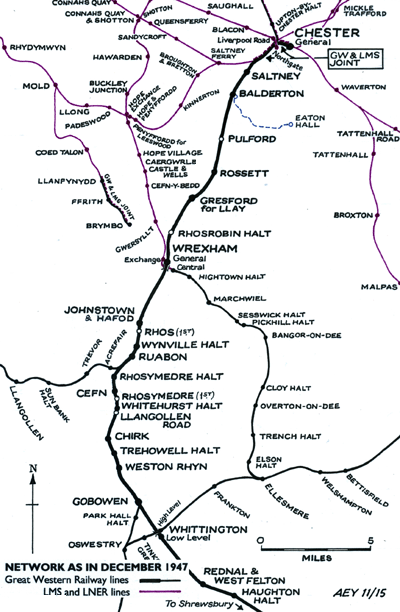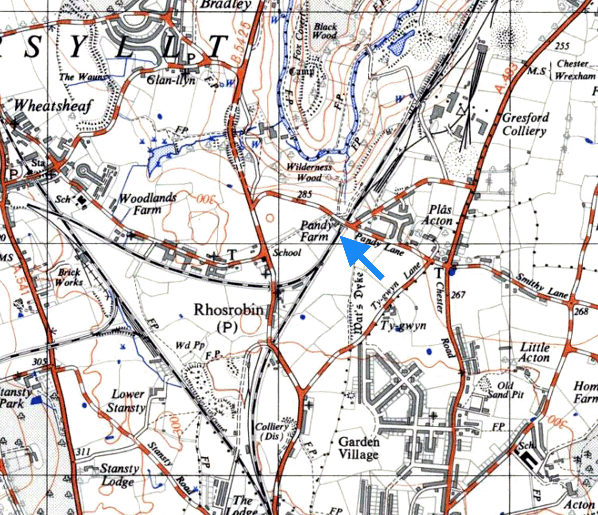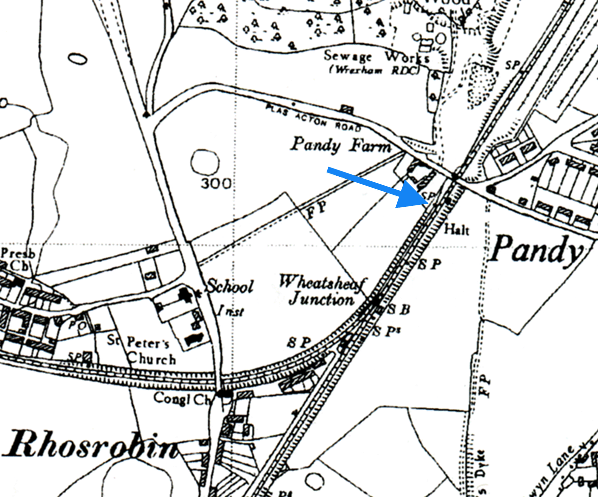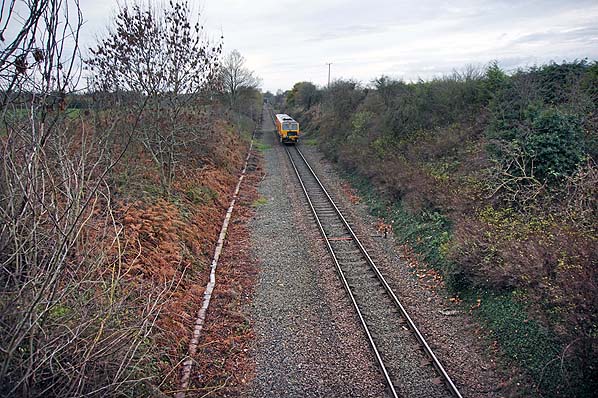|
Notes: Rhosrobin Halt was located on the Great Western Railway’s (GWR) main line that linked Birmingham to the River Mersey at Birkenhead via Chester. The section of line on which Rhosrobin was located (between Saltney Junction and Rhosymedre) had opened on 4 November 1846. It had been promoted by the North Wales Mineral Railway (NWMR) who started work on it in 1844. In July 1846 the NWMR merged with the Shrewsbury, Oswestry & Chester Junction Railway (who had been set up to create a route between Chester & Shrewsbury) to form the Shrewsbury & Chester Railway (S&CR). The S&CR opened an extension of the former NWMR from Rhosymedre to Shrewsbury on 14 October 1848. The GWR took over the line on 1 September 1854 (Click here to read more about the S&CR and the events that led to the takeover).
 The halt at Rhosrobin was authorised on 23 June 1932 and it opened on 1 September 1932 to serve the small settlement after which it was named as well as Gresford Colliery which was a short distance north, on the east side of the railway. The halt at Rhosrobin was authorised on 23 June 1932 and it opened on 1 September 1932 to serve the small settlement after which it was named as well as Gresford Colliery which was a short distance north, on the east side of the railway.
Rhosrobin Halt was situated on the north and south side of a road overbridge which carried Plas Acton Road over the line. Access was via pathways that linked the halt’s up (Shrewsbury direction) and down (Chester direction) platforms to the road.
The halt was very basic consisting of timber-edged platforms backfilled with cinders. On the platforms there were simple waiting shelters that had been recovered from Moss Halt and The Lodge Halt. The cost of providing the halt was £257 plus £63 for moving the shelters. When authorised it was to be called Pandy Bridge Halt.
Rhosrobin was served only by local stopping trains.
To the north of the halt there was a junction from which a branch ran to Gresford Colliery.
A short distance south-west of the halt was Wheatsheaf Junction where the Wheatsheaf branch diverged from the main line. The branch dated from the earliest days of the line and served industries in the Moss valley and Brymbo areas. The branch was very steeply graded and included inclined planes and a tunnel. The western end of the branch had closed in 1862 when the GWR opened less steeply graded branches to serve the area. When Rhosrobin Halt opened the Wheatsheaf branch remained in use only to serve Gwersyllt Colliery.
Rhosrobin and the Gresford Colliery were well served by local buses which proved to be more attractive to local people and the workers. As the halt had become unremunerative the GWR closed it on 6 October 1947. It was demolished soon after, leaving no trace.
.gif) On 1 January 1948 the line became part of British Railways [Western Region] (BR[WR]). It remained a busy trunk route until the mid 1960s when many main line services were diverted to other routes or ceased to run. By the late 1970s it had become a shadow of its former self and on 2 February 1986 it was singled. On 1 January 1948 the line became part of British Railways [Western Region] (BR[WR]). It remained a busy trunk route until the mid 1960s when many main line services were diverted to other routes or ceased to run. By the late 1970s it had become a shadow of its former self and on 2 February 1986 it was singled.
Following a period of passenger growth in the first decade of the twenty-first century the line was once again handling main line traffic, and sections of it (but not through Rhosrobin) were re-doubled in 2016.
Tickets from Michael Stewart and route map by Alan Young
Sources:
- A Regional History of the Railways of Great Britain - Volume II North & Mid Wales - Peter E Baughan - David & Charles 1980.
- Encyclopaedia of British Railway Companies - Christopher Awdry - Guild Publishing 1990.
- Great Western Halts - Volume 2 - Kevin Robertson - KRB Publications 2002.
- Paddington to the Mersey - Dr R. Preston Hendry & R. Powell Hendry - Oxford Publishing Company 1992.
- Railway Passenger Stations in Great Britain - a Chronology - Michael Quick - Railway & Canal Historical Society 2009.
To see the
other stations on the Shrewsbury - Chester General line
click on the station name: Shrewsbury S&C, Leaton, Oldwoods Halt, Baschurch,
Stanwardine Halt, Haughton Halt, Rednal & West Felton,
Whittington Low Level, Weston Rhyn, Llangollen Road, Whitehurst Halt, Rhosymedre, Cefn Rhosymedre Halt, Wynville Halt, Johnstown & Hafod,
Rhos, Gresford, Rossett, Pulford, Balderton and Saltney |

.jpg)

 Rhosrobin Halt shown on a six-inch scale map from 1946.
Rhosrobin Halt shown on a six-inch scale map from 1946. The site of Rhosrobin Halt looking south on 23 November 2015 as a Plasser & Theurer ballast tamping machine heads south towards Wrexham.
The site of Rhosrobin Halt looking south on 23 November 2015 as a Plasser & Theurer ballast tamping machine heads south towards Wrexham. Home Page
Home Page  The halt at Rhosrobin was authorised on 23 June 1932 and it opened on 1 September 1932 to serve the small settlement after which it was named as well as Gresford Colliery which was a short distance north, on the east side of the railway.
The halt at Rhosrobin was authorised on 23 June 1932 and it opened on 1 September 1932 to serve the small settlement after which it was named as well as Gresford Colliery which was a short distance north, on the east side of the railway. .gif) On 1 January 1948 the line became part of British Railways [Western Region] (BR[WR]). It remained a busy trunk route until the mid 1960s when many main line services were diverted to other routes or ceased to run. By the late 1970s it had become a shadow of its former self and on 2 February 1986 it was singled.
On 1 January 1948 the line became part of British Railways [Western Region] (BR[WR]). It remained a busy trunk route until the mid 1960s when many main line services were diverted to other routes or ceased to run. By the late 1970s it had become a shadow of its former self and on 2 February 1986 it was singled. 